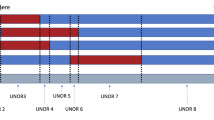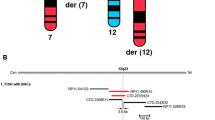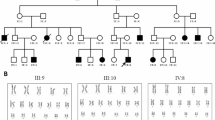Abstract
Among previously reported cases of 14q terminal deletions, only 11 have dealt with pure terminal deletion of 14q (14q3–14qter) and the break points were mapped by fluorescent in situ hybridisation (FISH) or genotyping in only four of them. Thanks to a collaborative study on behalf of the ‘Association des Cytogeneticiens de langue Française’(ACLF), we report two patients with terminal deletion of the long arm of chromosome 14, del(14)(q32.2) and del(14)(q32.32), diagnosed by subtelomere screening. In the two cases, a thick nuchal skinfold was detected by early ultrasound with normal prenatal karyotype. Their postnatal phenotype included large forehead, narrow palpebral fissures, epicanthic folds, upturned tip of the nose, narrow mouth and thin upper lip, microretrognathia, prominent earlobes, hypotonia, delayed psychomotor development and hypoplastic corpus callosum. By physical mapping using FISH, the size of the deletions was measured for patients 1 and 2: 6.55±1.05 and 4.67±0.10 Mb, respectively. The paternal origin of the deleted chromosome 14 was established by genotyping of microsatellites for patient 1 and the phenotype of terminal del(14)(q32) was compared to maternal uniparental disomy 14.
Similar content being viewed by others
Log in or create a free account to read this content
Gain free access to this article, as well as selected content from this journal and more on nature.com
or
References
Schinzel A : A Catalogue of Unbalanced Chromosomal Aberrations in Man. Berlin, New York: Walter de Gruyter, 2001, pp 525–541.
Meschede D, Exeler R, Wittwer B, Horst J : Submicroscopic deletion in 14q32.3 through a de novo tandem translocation between 14q and 21p. Am J Med Genet 1998; 80: 443–447.
Leube B, Majewski F, Drechsler M, Royer-Pokora B : Unbalanced cryptic translocation der(14)t(9;14)(q34.3;q32.33) identified by subtelomeric FISH. Clin Dysmorphol 2003; 12: 261–265.
Bregant L, Gersak K, Veble A : Distal trisomy 10q/partial monosomy 14q: an unusual clinical picture. Genet Couns 2005; 16: 59–63.
Uehara S, Akai Y, Takeyama Y et al: A case of a female infant with simultaneous occurrence of de novo terminal deletions on chromosome 14q and 20p. Clin Genet 1993; 43: 28–33.
Nielsen J, Homma A, Rasmussen K, Ried E, Sorensen K, Saldana-Garcia P : Deletion 14q and pericentric inversion 14. J Med Genet 1978; 15: 236–238.
Masada CT, Olney AH, Fordyce R, Sanger WG : Partial deletion of 14q and partial duplication of 14q in sibs: testicular mosaicism for t(14q;14q) as a common mechanism. Am J Med Genet 1989; 34: 528–534.
Magnani I, Sacchi N, Darfler M, Nisson PE, Tornaghi R, Fuhrman-Conti AM : Identification of the chromosome 14 origin of a C-negative marker associated with a 14q32 deletion by chromosome painting. Clin Genet 1993; 43: 180–185.
Chen CP, Chern SR, Lin SP et al: A paternally derived inverted duplication of distal 14q with a terminal 14q deletion. Am J Med Genet A 2005; 139: 146–150.
Maurin ML, Brisset S, Le Lorc’h M et al: Terminal 14q32.33 deletion: genotype–phenotype correlation. Am J Med Genet A 2006; 140: 2324–2329.
Hreidarsson SJ, Stamberg J : Distal monosomy 14 not associated with ring formation. J Med Genet 1983; 20: 147–149.
Wintle RF, Costa T, Haslam RH, Teshima IE, Cox DW : Molecular analysis redefines three human chromosome 14 deletions. Hum Genet 1995; 95: 495–500.
Miller BA, Jayakar P, Capo H : Child with multiple congenital anomalies and mosaicism 46, XX/46,XX, del (14)(q32.3). Am J Med Genet 1992; 44: 635–637.
Yen FS, Podruch PE, Weisskopf B : A terminal deletion (14)(q31.1) in a child with microcephaly, narrow palate, gingival hypertrophy, protuberant ears, and mild mental retardation. J Med Genet 1989; 26: 130–133.
Telford N, Thomson DA, Griffiths MJ, Ilett S, Watt JL : Terminal deletion (14)(q32.3): a new case. J Med Genet 1990; 27: 261–263.
Wang HS, Allanson JE : A further case of terminal deletion (14)(q32.2) in a child with mild dysmorphic features. Ann Genet 1992; 35: 171–173.
Ortigas AP, Stein CK, Thomson LL, Hoo JJ : Delineation of 14q32.3 deletion syndrome. J Med Genet 1997; 34: 515–517.
Mertens DJ, De Die-Smulders CE, Kampschoer PH et al: 14q terminal deletion: prenatal diagnosis in a child with severe congenital anomalies. Genet Couns 2000; 11: 341–346.
Van Karnebeek CD, Quik S, Sluijter S, Hulsbeek MM, Hoovers JM, Hennekam RC : Further delineation of the chromosome 14q terminal deletion syndrome. Am J Med Genet 2002; 110: 65–72.
Schlade-Bartusiak K, Costa T, Summers AM, Nowaczyk MJ, Cox DW : FISH-mapping of telomeric 14q32 deletions: search for the cause of seizures. Am J Med Genet A 2005; 138: 218–224.
Ravnan JB, Tepperberg JH, Papenhausen P et al: Subtelomere FISH analysis of 11 688 cases: an evaluation of the frequency and pattern of subtelomere rearrangements in individuals with developmental disabilities. J Med Genet 2006; 43: 478–489.
Dutrillaux B, Lejeune J : A new technic of analysis of the human karyotype. C R Acad Sci Hebd Seances Acad Sci D 1971; 272: 2638–2640.
Knight SJ, Lese CM, Precht KS et al: An optimized set of human telomere clones for studying telomere integrity and architecture. Am J Hum Genet 2000; 67: 320–332.
Howard PJ, Clark D, Dearlove J : Retinal/macular pigmentation in conjunction with ring 14 chromosome. Hum Genet 1988; 80: 140–142.
Turleau C, De Grouchy J, Bouveret JP : Distal trisomy 17q. Clin Genet 1979; 16: 54–57.
Lenzini E, Leszl A, Artifoni L, Casellato R, Tenconi R, Baccichetti C : Partial duplication of 17 long arm. Ann Genet 1988; 31: 175–180.
Brisset C, Kasakyan S, L’Hermine AC et al: De novo monosomy 9p24.3-pter and trisomy 17q24.3-qter characterised by microarray comparative genomic hybridisation in a fetus with an increased nuchal translucency. Prenat Diagn 2006; 26: 206–213.
Murphy SK, Wylie AA, Coveler KJ et al: Epigenetic detection of human chromosome 14 uniparental disomy. Hum Mutat 2003; 22: 92–97.
Hernandez A, Martinez ME, Fiering S, Galton VA, St Germain D : Type 3 deiodinase is critical for the maturation and function of the thyroid axis. J Clin Invest 2006; 116: 476–484.
Sutton VR, Coveler KJ, Lalani SR, Kashork CD, Shaffer LG : Subtelomeric FISH uncovers trisomy 14q32: lessons for imprinted regions, cryptic rearrangements and variant acrocentric short arms. Am J Med Genet 2002; 112: 23–27.
Acknowledgements
We are grateful to the patients and their families for their kind cooperation. We thank Dr M Rocchi for providing us with the 14q BAC clones from the Bari Resources for Molecular Cytogenetics. We thank S Knight who provided us the reference PAC GS-820M16. We thank Dr H Goldstein and Dr WV Bogomoletz for critical reading of the manuscript. This study was supported by the following grants:AOL 2001-2003 Reims CHU, Promotion: CHU-Bordeaux France, ACLF réseau télomère.
Author information
Authors and Affiliations
Corresponding author
Additional information
Electronic-database information http://www.ncbi.nlm.nih.gov/mapview/; http://ensembl.org/Homo_sapiens/cytoview
Rights and permissions
About this article
Cite this article
Schneider, A., Benzacken, B., Guichet, A. et al. Molecular cytogenetic characterization of terminal 14q32 deletions in two children with an abnormal phenotype and corpus callosum hypoplasia. Eur J Hum Genet 16, 680–687 (2008). https://doi.org/10.1038/sj.ejhg.5201977
Received:
Revised:
Accepted:
Published:
Issue date:
DOI: https://doi.org/10.1038/sj.ejhg.5201977
Keywords
This article is cited by
-
Copy number variants and infantile spasms: evidence for abnormalities in ventral forebrain development and pathways of synaptic function
European Journal of Human Genetics (2011)



